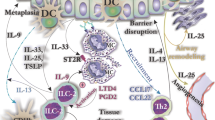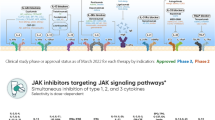Abstract
Background
We investigated the expression profile of toll-like receptors (TLRs) and TLR ligand-activated production profile of asthma-related inflammatory cytokines in asthmatic patients. The expression of TLR1–8 on monocytes, CD4+ T helper lymphocytes, CD8+ T cytotoxic lymphocytes, CD19+ B lymphocytes, and dendritic cells, and ex vivo production of cytokines from peripheral blood mononuclear cells activated by TLR ligands were measured by flow cytometry.
Discussion
Ex vivo productions of TNF-α, IL-10, and IL-1β by TLR4 and TLR5 ligand LPS and flagellin were significantly lower in asthmatic patients (all P < 0.05). Expression of TLR4 and TLR5 was also found to be significantly lower in asthmatic patients when compared to that of control subjects (all P < 0.05). Therefore, the decreased activation of TLR4 and TLR5 in asthmatic patients might contribute to the immunopathological mechanisms of asthma by reducing the release of Th1 and anti-inflammatory cytokines.






Similar content being viewed by others
References
Yssel H, Groux H. Characterization of T cell subpopulations involved in the pathogenesis of asthma and allergic diseases. Int Arch Allergy Immunol. 2000. 121:10–8. doi:10.1159/000024292.
Strachan DP. Family size, infection and atopy: the first decade of the “hygiene hypothesis”. Thorax. 2000. 55(Suppl 1):S2–10. doi:10.1136/thorax.55.suppl_1.S2.
Feleszko W, Jaworska J, Hamelmann E. Toll-like receptors—novel targets in allergic airway disease (probiotics, friends and relatives). Eur J Pharmacol. 2006. 533:308–18. doi:10.1016/j.ejphar.2005.12.062.
Bach JF. The effect of infections on susceptibility to autoimmune and allergic diseases. N Engl J Med. 2002. 347:911–20. doi:10.1056/NEJMra020100.
Wills-Karp M, Santeliz J, Karp CL. The germless theory of allergic disease: revisiting the hygiene hypothesis. Nat Rev Immunol. 2001. 1:69–75. doi:10.1038/35095579.
Dahl ME, Dabbagh K, Liggitt D, Kim S, Lewis DB. Viral-induced T helper type 1 responses enhance allergic disease by effects on lung dendritic cells. Nat Immunol. 2004. 5:337–43. doi:10.1038/ni1041.
Camateros P, Moisan J, Hénault J, De Sanctis J, Skamene E, Radzioch D. Toll-like receptors, cytokines and the immunotherapeutics of asthma. Curr Pharm Des. 2006. 12:2365–74. doi:10.2174/138161206777698918.
Bauer S, Hangel D, Yu P. Immunobiology of toll-like receptors in allergic disease. Immunobiology. 2007. 212:521–33. doi:10.1016/j.imbio.2007.03.011.
Hopkins PA, Sriskandan S. Mammalian Toll-like receptors: to immunity and beyond. Clin Exp Immunol. 2005. 140:395–407. doi:10.1111/j.1365-2249.2005.02801.x.
Schroder NW, Maurer M. The role of innate immunity in asthma: leads and lessons from mouse models. Allergy. 2007. 62:579–90. doi:10.1111/j.1398-9995.2007.01386.x.
Sukkar MB, Xie S, Khorasani NM, Kon OM, Stanbridge R, Issa R, et al. Toll-like receptor 2, 3, and 4 expression and function in human airway smooth muscle. J Allergy Clin Immunol. 2006. 118:641–8. doi:10.1016/j.jaci.2006.05.013.
O’Neill LA. How Toll-like receptors signal: what we know and what we don’t know. Curr Opin Immunol. 2006. 18:3–9. doi:10.1016/j.coi.2005.11.012.
Palazzo M, Gariboldi S, Zanobbio L, Dusio GF, Selleri S, Bedoni M, et al. Cross-talk among Toll-like receptors and their ligands. Int Immunol. 2008. 20:709–18. doi:10.1093/intimm/dxn027.
American Thoracic Society. Guidelines for the evaluation of impairment/disability in patients with asthma. Am Rev Respir Dis. 1993;147:1056–61.
American Thoracic Society. Standardization of spirometry, 1994 update. Am J Respir Crit Care Med. 1995;152:1107–36.
Lam KK, Pang SC, Allan WG, Hill LE, Snell NJ, Fayers PM, et al. Predictive nomograms for forced expiratory volume, forced vital capacity, and peak expiratory flow rate, in Chinese adults and children. Br J Dis Chest. 1983;77:390–6.
Bethesda, MD. National Heart, Blood, and Lung Institute. Global strategy for asthma management and prevention: WHO/NHLBI workshop report. National Heart, Lung, and Blood Institute, Publication No. 95-3659, 1995
Bethesda MD. National Asthma Education and Prevention Program. Expert panel report 2: Guidelines for the management of asthma. National Institutes of Health, Publication No. 97-4051, 1997
Wong CK, Cheung PF, Ip WK, Lam CW. Intracellular signaling mechanisms regulating toll-like receptor-mediated activation of eosinophils. Am J Respir Cell Mol Biol. 2007. 37:85–96. doi:10.1165/rcmb.2006-0457OC.
Gon Y. Toll-like receptors and airway inflammation. Allergol Int. 2008. 57:33–7. doi:10.2332/allergolint.R-07-157.
Iwasaki A, Medzhitov R. Toll-like receptor control of the adaptive immune responses. Nat Immunol. 2004. 5:987–95. doi:10.1038/ni1112.
Lauener RP, Birchler T, Adamski J, Braun-Fahrländer C, Bufe A, Herz U, et al. ALEX study group: expression of CD14 and Toll-like receptor 2 in farmers’ and non-farmers’ children. Lancet. 2002. 360:465–6. doi:10.1016/S0140-6736(02)09641-1.
Re F, Strominger JL. IL-10 released by concomitant TLR2 stimulation blocks the induction of a subset of Th1 cytokines that are specifically induced by TLR4 or TLR3 in human dendritic cells. J Immunol. 2004;173:7548–55.
Hawrylowicz CM. Regulatory T cells and IL-10 in allergic inflammation. J Exp Med. 2005. 202:1459–63. doi:10.1084/jem.20052211.
Hawrylowicz CM, O’Garra A. Potential role of interleukin-10-secreting regulatory T cells in allergy and asthma. Nat Rev Immunol. 2005. 5:271–83. doi:10.1038/nri1589.
Fiorentino DF, Zlotnik A, Mosmann TR, Howard M, O’Garra A. IL-10 inhibits cytokine production by activated macrophages. J Immunol. 1991;147:3815–22.
Agrawal S, Agrawal A, Doughty D, Gerwitz A, Blenis J, Van Dyke T, et al. Cutting edge: different Toll-like receptor agonists instruct dendritic cells to induce distinct Th responses via differential modulation of extracellular signal-regulated kinase-mitogen-activated protein kinase and c-Fos. J Immunol. 2003;171:4984–9.
Didierlaurent A, Ferrero I, Otten LA, Dubois B, Reinhardt M, Carlsen H, et al. Flagellin promotes myeloid differentiation factor 88-dependent development of Th2-type response. J Immunol. 2004;172:6922–30.
Cheung PF, Wong CK, Ip WK, Lam CW. FAK-mediated activation of ERK for eosinophil migration: a novel mechanism for infection-induced allergic inflammation. Int Immunol. 2008. 20:353–63. doi:10.1093/intimm/dxm146.
Hammad H, Lambrecht BN. Dendritic cells and epithelial cells: linking innate and adaptive immunity in asthma. Nat Rev Immunol. 2008. 8:193–204. doi:10.1038/nri2275.
Kadowaki N. Dendritic cells: a conductor of T cell differentiation. Allergol Int. 2007. 56:193–9. doi:10.2332/allergolint.R-07-146.
Semnani RT, Venugopal PG, Leifer CA, Mostböck S, Sabzevari H, Nutman TB. Inhibition of TLR3 and TLR4 function and expression in human dendritic cells by helminth parasites. Blood. 2008. 112:1290–8. doi:10.1182/blood-2008-04-149856.
Kline JN, Waldschmidt TJ, Businga TR, Lemish JE, Weinstock JV, Thorne PS, et al. Modulation of airway inflammation by CpG oligodeoxynucleotides in a murine model of asthma. J Immunol. 1998;160:2555–9.
Kline JN, Krieg AM, Waldschmidt TJ, Ballas ZK, Jain V, Businga TR. CpG oligodeoxynucleotides do not require TH1 cytokines to prevent eosinophilic airway inflammation in a murine model of asthma. J Allergy Clin Immunol. 1999. 104:1258–64. doi:10.1016/S0091-6749(99)70022-9.
Bohle B, Jahn-Schmid B, Maurer D, Kraft D, Ebner C. Oligodeoxynucleotides containing CpG motifs induce IL-12, IL-18 and IFN-gamma production in cells from allergic individuals and inhibit IgE synthesis in vitro. Eur J Immunol. 1999. 29:2344–53. doi:10.1002/(SICI)1521-4141(199907)29:07<2344::AID-IMMU2344>3.0.CO;2-R.
Persson CG, Erjefält JS, Korsgren M, Sundler F. The mouse trap. Trends Pharmacol Sci. 1997;18:465–7.
Schleimer RP. Glucocorticoids suppress inflammation but spare innate immune responses in airway epithelium. Proc Am Thorac Soc. 2004. 1:222–30. doi:10.1513/pats.200402-018MS.
Barrat FJ, Coffman RL. Development of TLR inhibitors for the treatment of autoimmune diseases. Immunol Rev. 2008. 223:271–83. doi:10.1111/j.1600-065X.2008.00630.x.
Author information
Authors and Affiliations
Corresponding author
Additional information
Samantha W. M. Lun and C. K. Wong contributed equally to this study.
Rights and permissions
About this article
Cite this article
Lun, S.W.M., Wong, C.K., Ko, F.W.S. et al. Expression and Functional Analysis of Toll-Like Receptors of Peripheral Blood Cells in Asthmatic Patients: Implication for Immunopathological Mechanism in Asthma. J Clin Immunol 29, 330–342 (2009). https://doi.org/10.1007/s10875-008-9269-1
Received:
Accepted:
Published:
Issue Date:
DOI: https://doi.org/10.1007/s10875-008-9269-1




